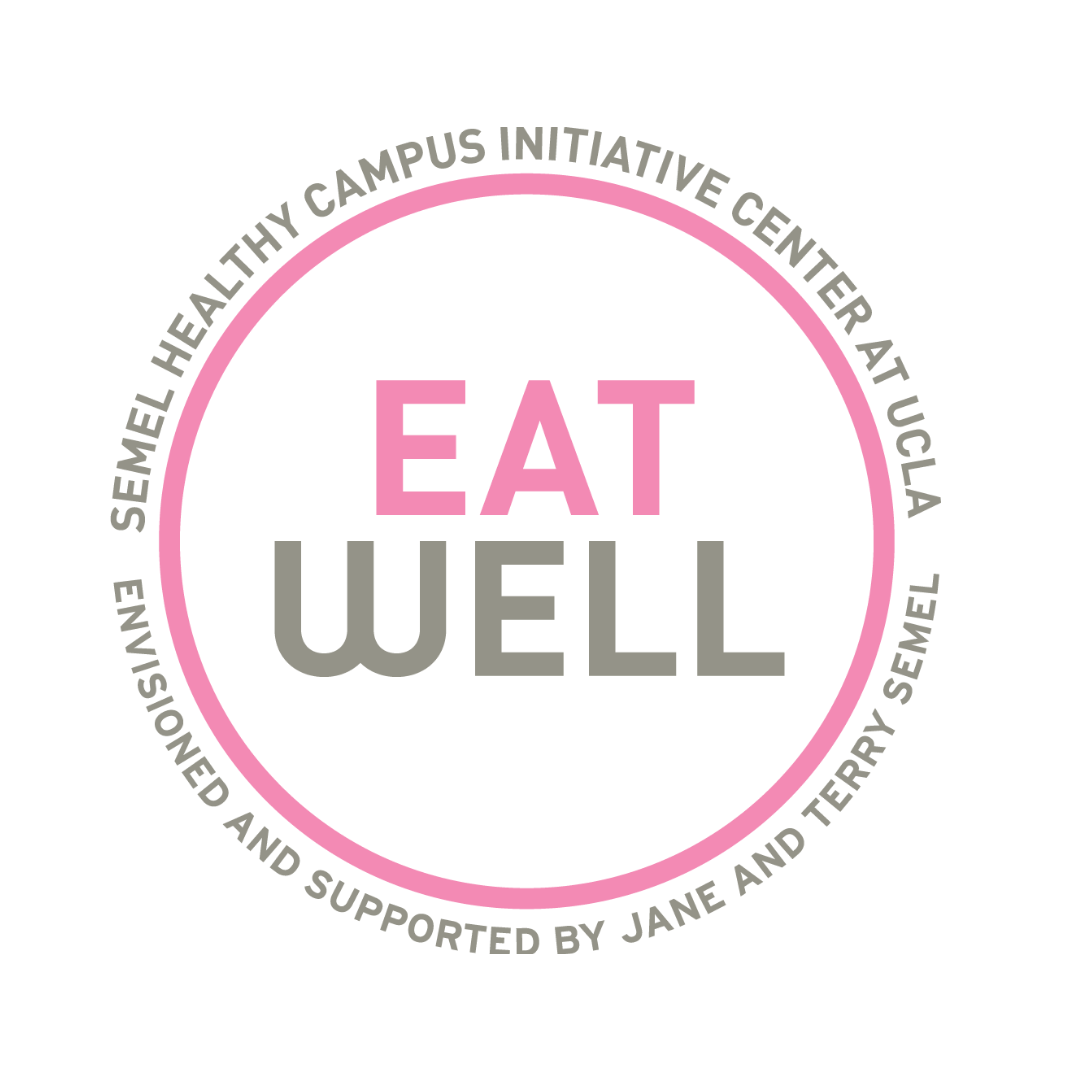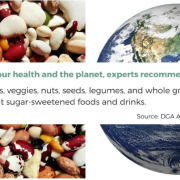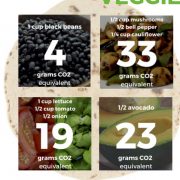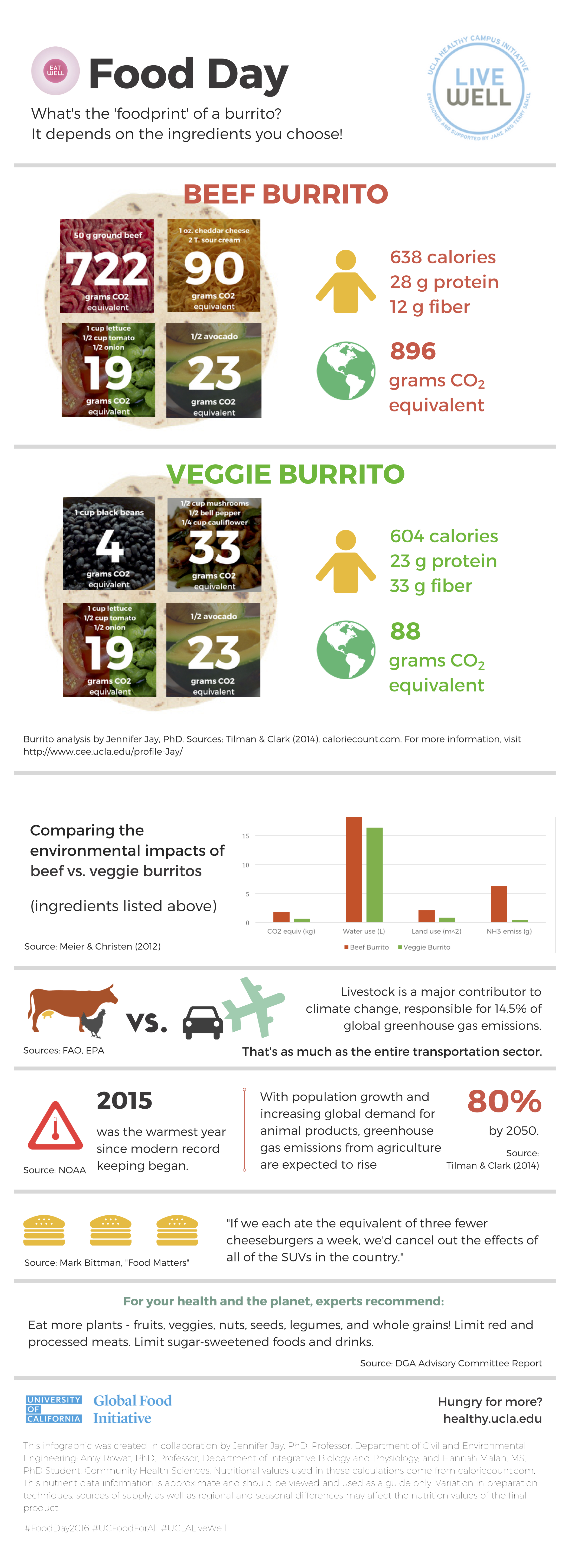Answers to your Food Week questions on food, health, and climate
In fall, the UCLA Healthy Campus Initiative hosted a Food Day panel discussion with three experts to help us better understand the environmental footprint of our food—our “foodprint.” We followed up with the panelists to answer some outstanding questions from our audience.
Meet the experts:
Dr. Jennifer (Jenny) Jay, PhD – Professor, UCLA Institute of Environment and Sustainability
Dr. Dana Hunnes, PhD, MPH, RD – Senior Dietitian, UCLA Medical Center and Assistant Adjunct Professor, UCLA Fielding School of Public Health
Elliot Mermel – CEO and Cofounder, Coalo Valley (Cricket) Farm
1. Are there alternative options (better than beef) that are meat-based?
Beef and lamb are the most resource-intensive meats, with production resulting in 26 and 23 kg CO2-eq per kg, respectively. This includes methane emissions that occur during ruminant respiration along with the carbon footprint of the feed and maintenance of the animals. In contrast, pork and poultry produce 7 and 5 kg CO2-eq per kg, respectively. Eggs and nuts generate 4 and 2 kg CO2-eq per kg. Beans produce just 0.8 kg CO2-eq per kg. – Jenny
(In other words, poultry and pork have a smaller carbon footprint than beef and lamb; but eggs, nuts, and beans are best!)
2. People say soy is bad for you. Should we limit the amount of soy protein we eat?
Soy is not bad for you at all! Asian countries eat a ton of soy and they are some of the healthiest long-lived people! I’m more worried about the naturally-occurring hormones in dairy products than I am in soy. – Dana
3. What is the “role” of packaged/processed food in this conversation (e.g. vegetable chips, etc.) or is the message that we need to emphasize cooking and preparing meals from scratch?
Eating as close to nature as possible is best. Cooking and preparing meals from scratch is always healthier than restaurant or packaged foods. However, looking for packaged/processed foods with as few ingredients as possible, recognizable ingredient names, and that are also low in sugar and salt can also have a place in the diet. For instance, frozen fruits and vegetables with no added ingredients can be just as nutritious as fresh. – Dana
4. What are the best nutrient rich grains and foods to incorporate into a plant-based diet? I know a few: quinoa, amaranth, lentils, mung beans.
Farro, bulgur or barley, split peas, whole-grain/brown rice, black beans—almost any type of bean really! Wheat berries, spelt, etc. – Dana
5. I’ve heard feeding seaweed to cows reduces methane production. Is this technique legit?
Livestock are responsible for a huge fraction, 44%, of anthropogenic methane, a greenhouse gas with much more warming potential than carbon dioxide. There is some recent work showing that in a laboratory simulation of a cow’s digestive system, additions of relatively small amounts of seaweed (equivalent to 2% of the cattle feed) did result in greater than a 70% decrease in methane production. Some work with live sheep also has shown significant decreases.
The technology is new, so long term impacts on productivity and animal health have not yet been evaluated. Also, this technology would only apply to the feedlot segment of the animal’s life. Typically, cattle spend most of their lives on pasture and then move to a feedlot for “finishing.”
It is important to note that due to methane production throughout the lifespan (pasture and feedlot), the carbon footprint of ruminants is much, much higher than that of other protein sources (see my response to question 1). Even with the substantial reduction of methane from ruminant respiration during the feedlot period, there are still more climate friendly ways to gain protein. – Jenny
6. What should we do with our food waste if we don’t have access to compost bins?
Given the important role that reducing food waste can play in lessening our “foodprint,” we can all strive to get better at generating less waste. For example, we can take plastic containers with us to restaurants, which encourages us to pack up and eat later what we might have thrown away. This saves the disposable take out containers as well!
Careful meal planning does take time, but it provides huge benefits in the way of reducing waste, increasing our consumption of healthy foods (and decreasing our reliance on those typically less-healthy last minute options), and saving money.
Try to spend some weekend time deciding what you’ll eat during the week. You might really like the extra time this gives you to buy and prep the foods you’ll be eating. If you do tend to change plans a lot, you’ll need to be careful with buying perishables. Remember you can always freeze your veggies and leftovers.
Finally, it’s great to learn how to make a simple soup that can help you use up stray veggies, beans, and pasta in your fridge. This can be as simple as boiling up veggies in broth, and running it through your blender. Cashews and white potatoes will add a creamy texture. Similarly, smoothies will help reduce fruit and greens waste—you can freeze fruits and greens ahead, and then spin them up for a quick and healthy breakfast. – Jenny
7. Is eating insects really a promising alternative to conventional meats?
Traditional diets across Asia, Africa, and Latin America incorporate insects as important sources of protein—often as delicious delicacies! While the act of eating insects is not yet a widely appreciated source of sustainable protein in the western world, with dwindling land, water, and resources and trending environmental-consciousness, insect consumption is more than just a fad; it’s the food of the future.
Tens of millions of dollars has been injected into the edible insect industry across North America and Europe over the past few years and hopefully this belief in sustainable protein production will trickle down to the plates of consumers. – Elliot
8. How many crickets would you have to eat to make the protein gained in beef? Does this offset environmental benefits?
Comparing raw crickets and raw beef, per 100g, crickets have 8-25g of protein while beef has 19-26g of protein. In general, insects require six times less feed than cattle to produce the same amount of protein and emit less greenhouse gasses.
From personal experience and basic research, I say that there are many environmental benefits (less land use, water and feed use, greenhouse gas emissions) of raising crickets compared to traditional techniques of beef production. – Elliot
9. Can you talk about DIY, home-based insect production? Are you thinking about offering classes in mealworm husbandry?
One of the toughest parts of insect farming is dialing in the variables specific to the space you are raising them in. Since this is a natural aspect of all DIY projects, I encourage people to take the leap and go through the trial and error period. There are many open-source forums online that can help solve problems.
We are willing to offer basic help to anyone in need of insect raising advice but keep in mind that the majority of hindrances in an individual’s farming will be lack of insect-specific equipment, a market that is still in its larval stages. – Elliot
“Sustainable diets are those diets with low environmental impacts which contribute to food and nutrition security and to healthy life for present and future generations. Sustainable diets are protective and respectful of biodiversity and ecosystems, culturally accepted, accessible, economically fair and affordable; nutritional adequate, safe and healthy; while optimizing natural and human resources.” – Food and Agriculture Organization of the United Nations
Written by Hannah Malan, Graduate Student Researcher, EatWell




